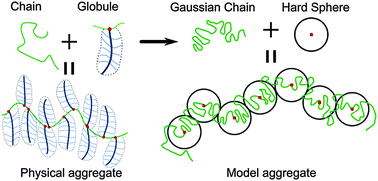Beads on a string: structure of bound aggregates of globular particles and long polymer chains
Abstract
Macroscopic properties of suspensions, such as those composed of globular particles (e.g., colloidal or macromolecular), can be tuned by controlling the equilibrium aggregation of the particles. We examine how aggregation – and, hence, macroscopic properties – can be controlled in a system composed of both globular particles and long, flexible polymer chains that reversibly bind to one another. We base this on a minimal statistical mechanical model of a single aggregate in which the polymer chain is treated either as ideal or self-avoiding, and, in addition, the globular particles are taken to interact with one another via excluded volume repulsion. Furthermore, each of the globular particles is taken to have one single site to which at most one polymer segment may bind. Within the context of this model, we examine the statistics of the equilibrium size of an aggregate and, thence, the structure of dilute and semidilute suspensions of these aggregates. We apply the model to biologically relevant aggregates, specifically those composed of macromolecular proteoglycan globules and long hyaluronan polymer chains. These aggregates are especially relevant to the materials properties of cartilage and the structure–function properties of perineuronal nets in brain tissue, as well as the pericellular coats of mammalian cells.


 Please wait while we load your content...
Please wait while we load your content...